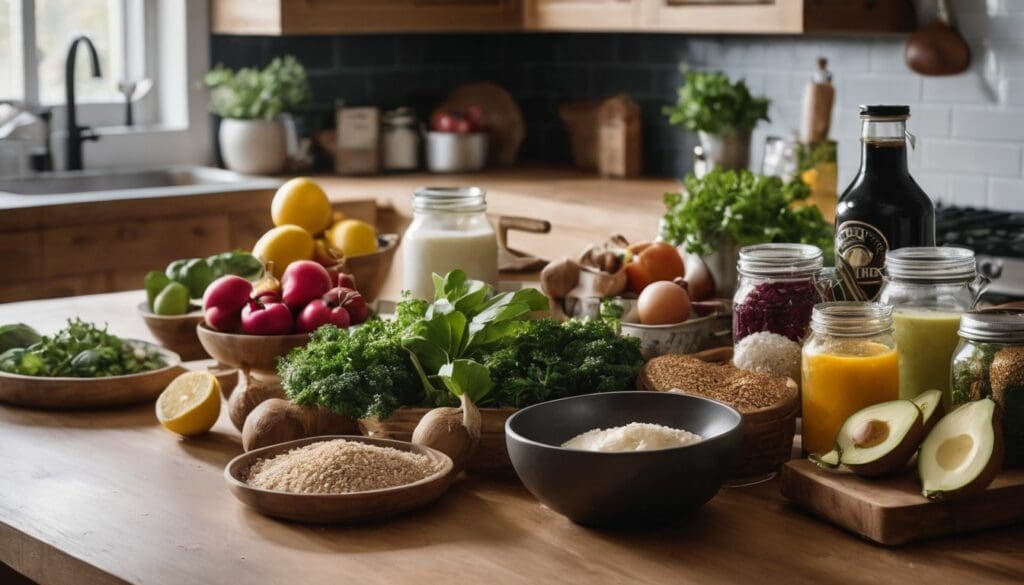We all know the feeling, don’t we? That desire to make our time in the kitchen count for both taste and the planet. Rest assured, you’re in good company; I’ve grappled with this challenge and uncovered a rather alarming fact: approximately one-third of food globally ends up as waste.
Our guide is designed to take you by the hand and show you how hosting a sustainable cooking class can transform not only our culinary habits but also our perspectives on food consumption.
Prepare yourself to whip up delicious dishes that are as kind to Mother Earth as they are delightful to your palate!
Key Takeaways
- Sustainable cooking classes teach the importance of mindful eating by using locally sourced ingredients and zero-waste practices, leading to healthier habits and reduced environmental impact.
- A successful sustainable cooking class requires market research, a comprehensive business plan, obtaining all necessary legal permits and licences, and building strong relationships with local farmers and vendors for fresh produce.
- Involving students in lessons about sustainable food production helps them understand the connection between their dietary choices and the environment, promoting lifelong eco-friendly habits.
Benefits of Sustainable Cooking Class
Engaging in a sustainable cooking class promotes mindful eating and healthier cooking habits while also educating participants about the impact of food on the environment. It encourages conscious kitchen practices and fosters a better understanding of how our food choices can contribute to a more sustainable future.
Mindful eating and healthier cooking
We embrace mindful eating as a core principle in our sustainable cooking classes. It’s about savouring each bite and recognising the journey food takes from farm to table. We encourage participants to consider the origins of their ingredients, opting for locally sourced produce whenever possible.
This awareness helps us appreciate food more deeply and paves the way for healthier cooking habits.
Our workshops explore various sustainable cooking techniques that can easily be adopted at home. We focus on zero-waste practices like using every part of an ingredient and limiting plastic usage.
Plant-based recipes feature prominently, offering tasty alternatives that are kinder to both our bodies and the planet. By adopting these practices, we all step closer towards sustainable living – one meal at a time.
Understanding the impact of food on the environment
Food has a significant impact on the environment, influencing factors such as greenhouse gas emissions, water usage, and land degradation. By choosing sustainable cooking practices and ingredients that support ethical food choices, we can reduce these negative effects.
Opting for farm-to-table produce, zero-waste cooking methods, and plant-based recipes are just some examples of how we can contribute to healthier ecosystems while enjoying delicious meals.
Embracing sustainable food systems not only benefits our health but also supports environmental conservation efforts. Making thoughtful choices about the foods we consume allows us to be mindful of our ecological footprint and promote green living in our communities.
Conscious kitchen practices
After understanding the impact of food on the environment, we can now delve into conscious kitchen practices to support a sustainable cooking class. It involves adopting eco-friendly habits like reducing food waste, using energy-efficient appliances, and sourcing ingredients from local and ethical suppliers.
Emphasising plant-based cooking and zero-waste techniques also align with the principles of sustainable cooking workshops. Incorporating these mindful practices not only promotes healthier cooking but also contributes to environmental preservation while supporting local farmers and vendors.
Conscious kitchen practices entail making thoughtful choices about food preparation, storage, and consumption. This includes opting for reusable containers instead of single-use plastics, composting organic waste, and promoting sustainable farming methods among the culinary community.
How to Start a Successful Sustainable Cooking Class
Researching the market and target audience is essential to understand the demand for sustainable cooking classes. Developing a comprehensive business plan, obtaining necessary permits and licenses, and building a network of local farmers and vendors are crucial steps to starting a successful sustainable cooking class.
Researching the market and target audience
To ensure the success of our sustainable cooking class, we examine the market and identify our target audience. By conducting thorough research, we gain insights into the community’s interest in eco-friendly culinary programs and healthy eating.
Understanding our potential participants’ preferences allows us to tailor our classes to meet their needs and expectations. This also helps us develop a compelling marketing strategy that resonates with environmentally conscious individuals seeking culinary education with an emphasis on food sustainability.
Identifying local farmers, vendors, and suppliers who align with our values is crucial for sourcing high-quality ingredients for our sustainable cooking class. By building a network within the community, we contribute to the farm-to-table movement while supporting ethical food choices.
Developing a comprehensive business plan
To start a successful sustainable cooking class, we need to develop a comprehensive business plan. This involves researching the market and understanding our target audience’s needs and preferences.
Obtaining necessary permits and licences is vital to ensure compliance with local regulations. Building a network of local farmers and vendors enables us to source fresh, sustainable ingredients for our classes.
Creating a robust marketing strategy will help us reach environmentally conscious individuals who are passionate about healthy, ethical eating practices.
In addition, it’s crucial that our business plan outlines clear objectives and financial projections. Identifying key metrics for success allows us to measure our progress towards environmental sustainability and culinary education goals.
Obtaining necessary permits and licenses
To conduct a sustainable cooking class, we need to obtain the necessary permits and licences. This is essential in ensuring that the class operates legally and meets health and safety standards. Here are the steps to obtain these permits and licences:
- Research the specific permits and licences required for offering cooking classes in your area. This may include food service permits, business licences, and zoning permits.
- Contact the local health department or relevant authority to understand the application process and requirements for obtaining these permits.
- Prepare all necessary documentation such as business plans, proof of insurance, and facility layout plans as per the guidelines provided by the authorities.
- Complete and submit the applications for the required permits and licences along with any associated fees.
- Schedule inspections of your cooking class facilities by health inspectors to ensure compliance with hygiene and safety regulations.
- Address any feedback or issues identified during inspections to secure final approval for operating your sustainable cooking class legally.
- Display all obtained permits and licences prominently within your cooking class premises as a sign of credibility and transparency with your students.
Building a network of local farmers and vendors
After obtaining necessary permits and licenses, the next step in starting a sustainable cooking class is building a network of local farmers and vendors. Connecting with local producers not only supports the community but also ensures that you have access to fresh, seasonal produce for your classes.
By forging these partnerships, we can promote farm-to-table practices and reduce the carbon footprint associated with transporting food long distances.
Engaging with local farmers and vendors allows us to educate our students about where their food comes from while supporting ethical and sustainable agricultural practices. This collaboration helps to build a sense of community and reinforces the importance of environmental stewardship in our cooking classes.
Creating a marketing strategy
After building a network of local farmers and vendors, the next step is to create a marketing strategy that effectively promotes your sustainable cooking class. Start by identifying your target audience and conducting market research to understand their needs and preferences.
Develop a comprehensive business plan outlining your unique selling proposition, pricing strategy, and promotional tactics. Utilise social media platforms and local community events to raise awareness about your eco-friendly culinary programme.
Collaborate with like-minded businesses and organisations to reach a wider audience while emphasising the benefits of environmentally conscious cooking practices. By implementing an effective marketing strategy, you can attract individuals who are passionate about supporting conservation efforts through sustainable cooking initiatives.
Tips for Sustainable Cooking in the Classroom
– Making connections to lessons being taught can help students understand the relevance of sustainable cooking in their everyday lives. Incorporating information about cooking practices and teaching students about sustainable and ethical food choices are essential for a successful sustainable cooking class experience.
Making connections to lessons being taught
Teaching sustainable cooking in the classroom allows students to make real-world connections to their lessons. By demonstrating how cooking practices can impact the environment, students gain a deeper understanding of sustainable and ethical food choices.
Integrating information about healthy and eco-friendly cooking techniques into the curriculum empowers students to embrace mindful eating and greener culinary practices.
Incorporating lessons on farm-to-table, zero-waste, and plant-based cooking not only encourages environmental awareness but also fosters a sense of responsibility towards our planet.
Incorporating information about cooking practices
When teaching a sustainable cooking class, it’s important to incorporate information about cooking practices in a way that engages students. By demonstrating the use of locally sourced ingredients and promoting zero-waste cooking techniques, participants can gain a deeper understanding of sustainable kitchen habits.
Encouraging students to explore plant-based recipes and showcasing eco-friendly culinary tools also helps in fostering an environmentally conscious approach to cooking.
Integrating information about ethical food choices and mindful meal preparation into the curriculum further enhances the learning experience for aspiring chefs. Emphasising the importance of reducing food waste and utilising seasonal produce not only promotes sustainability but also empowers individuals with practical skills for creating healthy and planet-friendly meals.
Teaching students about sustainable and ethical food choices
When teaching students about sustainable and ethical food choices, we emphasise the importance of considering the environmental impact of food production. By incorporating these principles into our cooking classes, we aim to raise awareness about the benefits of supporting local farmers and using seasonal produce.
It also gives us an opportunity to educate future generations on making conscious decisions that contribute to a healthier planet.
Incorporating lessons on sustainable and ethical food choices allows us to empower students with the knowledge needed to make informed decisions about their dietary habits in alignment with environmentally conscious practices.
Conclusion
In conclusion, conducting a sustainable cooking class offers numerous benefits for both individuals and the environment. By providing hands-on experience in mindful eating and healthier cooking, participants can develop a deeper understanding of the impact of food on the planet.
With careful planning and implementation, educators can foster conscious kitchen practices among their students. Incorporating sustainable cooking into educational programs not only promotes environmental stewardship but also encourages healthier, more ethical food choices in a practical and engaging way.
FAQs
1. What is a sustainable cooking class?
A sustainable cooking class teaches you how to cook in an eco-friendly way, focussing on plant-based recipes, zero-waste techniques, and using local farm-to-table ingredients.
2. Why should I consider joining a green culinary programme?
Joining a green culinary programme helps you learn healthy cooking practices that are better for the environment and can lead to creating nutritious meals that benefit your well-being.
3. Can sustainable cooking really make a difference?
Yes! Sustainable cooking benefits the planet by reducing waste and supporting local agriculture, making it an important step towards eco-friendly living.
4. How do I start with zero-waste cooking in my classes?
Start with easy steps like planning meals around seasonal produce from nearby farms, teaching methods to use every part of an ingredient and sharing ideas on storing leftovers properly to avoid food waste.





